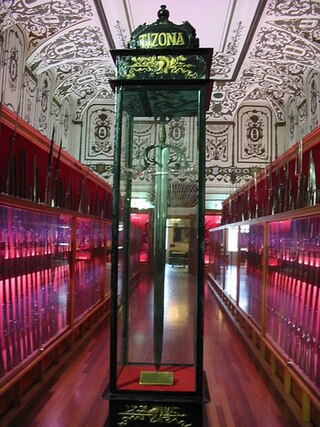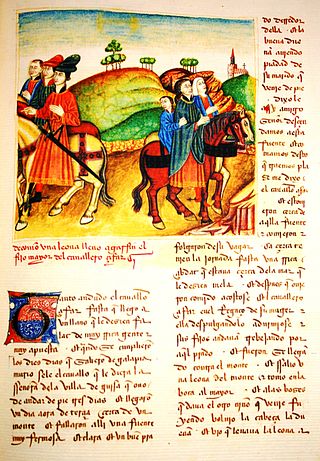
Rodrigo Díaz de Vivar was a Castilian knight and ruler in medieval Spain. Fighting both with Christian and Muslim armies during his lifetime, he earned the Arabic honorific as-Sayyid, which would evolve into El Çid, and the Spanish honorific El Campeador. He was born in Vivar, a village near the city of Burgos. As the head of his loyal knights, he came to dominate the Levante of the Iberian Peninsula at the end of the 11th century. He reclaimed the Taifa of Valencia from Muslim control for a brief period during the Reconquista, ruling the principality as its lord from 17 June 1094 until his death in 1099. His wife, Jimena Díaz, inherited the city and maintained it until 1102 when it was reconquered by the Moors.

El Cantar de mio Cid, or El Poema de mio Cid, also known in English as The Poem of the Cid, is the oldest preserved Castilian epic poem. Based on a true story, it tells of the deeds of the Castilian hero Rodrigo Díaz de Vivar—known as El Cid—and takes place during the eleventh century, an era of conflicts in the Iberian Peninsula between the Kingdom of Castile and various Taifa principalities of Al-Andalus. It is considered a national epic of Spain.

Tizona is the name of one of the swords carried by Rodrigo Díaz de Vivar, El Cid, according to the Cantar de Mio Cid. The name of the second sword of El Cid is Colada.
Spanish names are the traditional way of identifying, and the official way of registering, a person in Spain. They are composed of a given name and two surnames. Traditionally, the first surname is the father's first surname, and the second is the mother's first surname. Since 1999, the order of the surnames in a family in Spain is decided when registering the first child, but the traditional order is nearly universally chosen.

Tiago Cardoso Mendes, known simply as Tiago, is a Portuguese football manager and former player who played as a midfielder.

Didacus of Alcalá, also known as Diego de San Nicolás, was a Spanish Franciscan lay brother who served as among the first group of missionaries to the newly conquered Canary Islands. He died at Alcalá de Henares on 12 November 1463 and is now honoured by the Catholic Church as a saint.

Água de Pau is a civil parish in the municipality of Lagoa in the Portuguese archipelago of the Azores. The population in 2011 was 3,058, in an area of 17.46 km². It contains the localities Água de Pau, Caloura, Cerco, Cinzeiro, Galera and Jubileu.
Rodrigo is a Spanish, Portuguese and Italian name derived from the Germanic name Roderick, given specifically in reference to either King Roderic, the last Visigothic ruler or to Saint Roderick, one of the Martyrs of Córdoba . The modern given name has the short forms Ruy, Rui, and in Galician Roy, Roi.
This article concerns poetry in Spain.
Santiago is a masculine Spanish name that derives from the Hebrew name Jacob (Ya'akov) via "Sant Iago", "Sant Yago", "Santo Iago", or "Santo Yago", first used to denote Saint James the Great, the brother of John the Apostle. It is traditionally believed that Saint James (Santiago) had travelled to the Iberian Peninsula during his life and was buried there. The name is complicated in Spanish in that Jaime and Jacobo are modern versions of James.

Jacob is a common masculine given name of Hebrew origin. The English form is derived from the Latin Iacobus, from the Greek Ἰάκωβος (Iakobos), ultimately from the Hebrew יַעֲקֹב (Yaʿaqōḇ), the name of Jacob, biblical patriarch of the Israelites, and a major figure in the Abrahamic religions. The name comes either from the Hebrew root עקב ʿqb meaning "to follow, to be behind" but also "to supplant, circumvent, assail, overreach", or from the word for "heel", עֲקֵב ʿaqeb. It can also be taken to mean "may God protect."

James is an English language given name of Hebrew origin, most commonly used for males.

A duende is a humanoid figure of folklore, with variations from Iberian, Ibero American, and Latin American cultures, comparable to dwarves, gnomes, or leprechauns. In Spanish duende originated as a contraction of the phrase dueñ(o) de casa, effectively "master of the house", or perhaps derived from some similar mythical being of the Visigoth or Swabian culture given its comparable looks with the “Tomte” of the Swedish language conceptualized as a mischievous spirit inhabiting a dwelling.

The Mocedades de Rodrigo is an anonymous Castilian cantar de gesta, composed around 1360, that relates the origins and exploits of the youth of the legendary hero El Cid.
Old Spanish, also known as Old Castilian, or Medieval Spanish, was originally a dialect of Vulgar Latin spoken in the former provinces of the Roman Empire that provided the root for the early form of the Spanish language that was spoken on the Iberian Peninsula from the 9th century until roughly the beginning of the 15th century, before a series of consonant shifts gave rise to modern Spanish. The poem Cantar de Mio Cid, published around 1200, is the best known and most extensive work of literature in Old Spanish.

Geraldo Geraldes or Gerald the Fearless, known in Portuguese as Geraldo Sem Pavor, was a Portuguese warrior and folk hero of the Reconquista whose theatre of operations was in the barren Alentejo and Extremadura regions of the lower Guadiana river. The city of Évora was the most lasting of his conquests and was never retaken. His success and independence have suggested parallels with the Castilian hero El Cid and Gerald has been called "the Cid of Portugal".

The Marquisate of Cenete is a noble title first granted in 1491 by Queen Isabel I of Castile to Rodrigo Díaz de Vivar y Mendoza, First Count del Cid.

Medieval Spanish literature consists of the corpus of literary works written in Old Spanish between the beginning of the 13th and the end of the 15th century. Traditionally, the first and last works of this period are taken to be respectively the Cantar de mio Cid, an epic poem whose manuscript dates from 1207, and La Celestina (1499), a work commonly described as transitional between the Middle Ages and the Renaissance.
The Banu Gómez were a powerful but fractious noble family living on the Castilian marches of the Kingdom of León from the 10th to the 12th centuries. They rose to prominence in the 10th century as counts in Saldaña, Carrión and Liébana, and reached their apogee when, allied with Córdoba warlord, Almanzor, their head, García Gómez, expelled king Vermudo II of León and briefly ruled there. He would reconcile with the royal family, but launched two subsequent rebellions. On his death, the senior line of the family was eclipsed, but a younger branch would return to prominence, producing Pedro Ansúrez, one of the premier noblemen under king Alfonso VI and queen Urraca in the late 11th and early 12th centuries. The family would be portrayed in the Cantar de Mio Cid as rivals and antagonists of the hero, El Cid, and their rebellions would serve as a basis for the legend of Bernardo del Carpio.
Diego Rodríguez or Diego Ruiz was the only son of Rodrigo Díaz de Vivar, El Cid Campeador, and his wife, Jimena Díaz.












